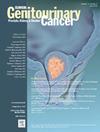UGN-102治疗低级别中危非肌肉浸润性膀胱癌:来自单臂2b期Optima II研究5年长期扩展研究的结果
IF 2.7
3区 医学
Q3 ONCOLOGY
引用次数: 0
摘要
OPTIMA II 2b期研究(NCT03558503)使用含有丝裂霉素的逆热水凝胶UGN-102治疗低级别中危非肌肉浸润性膀胱癌(lgir - nmibc)患者。这项为期12个月的父母研究报告了疗效和安全性结果;在这里,我们报告了5年的随访数据。患者和方法:参加OPTIMA II研究并在6周剂量UGN-102后达到完全缓解(CR)的患者在初始CR后随访长达9个月。研究完成时出现CR的患者有资格参加进一步的长期随访(LTFU)研究,在此期间没有方案规定的干预/治疗,方案规定的就诊或评估。监督医生每半年提供患者疾病状况的最新信息。反应持续时间(DoR)采用Kaplan-Meier法计算。结果:41例患者在3个月时达到CR, 25例在12个月时保持CR, 17例进入LTFU。41例患者在3个月时达到CR, DoR的中位Kaplan-Meier估计为24.2个月(95%可信区间[CI], 9.72-42.09),中位随访时间为35.8个月(95% CI, 10.78-60.98)。在LTFU研究中的17例患者中,中位DoR为42.1个月(95% CI, 24.18,不可估计[NE]),中位随访时间为50.40个月(95% CI, 26.97-NE)。结论:这些结果表明,UGN-102治疗对LG-IR-NMIBC患者具有临床意义和高度持久的疗效。UGN-102可能为LG-IR-NMIBC患者提供经尿道膀胱癌切除术(turt)的一种有希望的非手术替代方案。本文章由计算机程序翻译,如有差异,请以英文原文为准。
Treatment of Low-Grade Intermediate-Risk Non-Muscle Invasive Bladder Cancer With UGN-102: Outcomes From the 5-Year Long-Term Extension Study of the Single-Arm, Phase 2b Optima II Study
Introduction
The OPTIMA II phase 2b study (NCT03558503) treated patients with low-grade intermediate-risk non-muscle invasive bladder cancer (LG-IR-NMIBC) with UGN-102, a reverse thermal hydrogel containing mitomycin. Efficacy and safety results have been reported for the 12-month parent study; here, we report 5-year follow-up data.
Patients and Methods
Patients who participated in the OPTIMA II study and achieved a complete response (CR) after 6 weekly doses of UGN-102 were followed for up to 9 months after initial CR. Those with CR at study completion were eligible to enroll in a further long-term follow-up (LTFU) study, during which there were no protocol-specified interventions/treatments, protocol-specified visits, or evaluations. Supervising physicians provided semiannual updates on patients’ disease status. Duration of response (DoR) was calculated using the Kaplan–Meier method.
Results
Of the 41 patients achieving a CR at 3 months, 25 remained in CR at 12 months and 17 entered LTFU. For the 41 patients achieving a CR at 3 months the median Kaplan–Meier estimate of DoR was 24.2 months (95% confidence interval [CI], 9.72-42.09), with a median follow-up time of 35.8 months (95% CI, 10.78-60.98). For the 17 patients in the LTFU study the median DoR was 42.1 months (95% CI, 24.18-not estimable [NE]), with a median follow-up of 50.40 months (95% CI, 26.97-NE),
Conclusion
These results demonstrate that treatment with UGN-102 results in clinically meaningful, and highly durable response in patients with LG-IR-NMIBC. UGN-102 may offer a promising non-surgical alternative to transurethral resection of bladder cancer (TURBT) for LG-IR-NMIBC patients.
求助全文
通过发布文献求助,成功后即可免费获取论文全文。
去求助
来源期刊

Clinical genitourinary cancer
医学-泌尿学与肾脏学
CiteScore
5.20
自引率
6.20%
发文量
201
审稿时长
54 days
期刊介绍:
Clinical Genitourinary Cancer is a peer-reviewed journal that publishes original articles describing various aspects of clinical and translational research in genitourinary cancers. Clinical Genitourinary Cancer is devoted to articles on detection, diagnosis, prevention, and treatment of genitourinary cancers. The main emphasis is on recent scientific developments in all areas related to genitourinary malignancies. Specific areas of interest include clinical research and mechanistic approaches; drug sensitivity and resistance; gene and antisense therapy; pathology, markers, and prognostic indicators; chemoprevention strategies; multimodality therapy; and integration of various approaches.
 求助内容:
求助内容: 应助结果提醒方式:
应助结果提醒方式:


